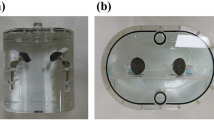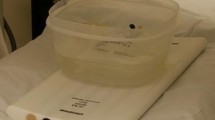Abstract
Objective
The aim of the study was to assess the performance and diagnostic value of a dual energy CT approach to reduce metal artefacts in subjects with metallic implants.
Methods
31 patients were examined in the area of their metallic implants using a dual energy CT protocol (filtered 140 kVp and 100 kVp spectrum, tube current relation: 3:1). Specific post-processing was applied to generate energies of standard 120 and 140 kVp spectra as well as a filtered 140 kVp spectrum with mean photon energies of 64, 69 and 88 keV, respectively, and an optimized hard spectrum of 95–150 keV. Image quality and diagnostic value were subjectively and objectively determined.
Results
Image quality was rated superior to the standard image in 29/31 high energy reconstructions; the diagnostic value was rated superior in 27 patients. Image quality and diagnostic value scores improved significantly from 3.5 to 2.1 and from 3.6 to 1.9, respectively. In several exams decisive diagnostic features were only discernible in the high energy reconstructions. The density of the artefacts decreased from −882 to −341 HU.
Conclusions
Dual Energy CT with specific postprocessing can reduce metal artefacts and may significantly enhance diagnostic value in the evaluation of metallic implants.






Similar content being viewed by others
References
Barrett JF, Keat N (2004) Artifacts in CT: recognition and avoidance. Radiographics 24:1679–1691
Graser A, Becker CR, Staehler M, et al. Single-phase dual-energy CT allows for characterization of renal masses as benign or malignant. Invest Radiol 45:399–405
Graser A, Johnson TR, Bader M et al (2008) Dual energy CT characterization of urinary calculi: initial in vitro and clinical experience. Invest Radiol 43:112–119
Haramati N, Staron RB, Mazel-Sperling K et al (1994) CT scans through metal scanning technique versus hardware composition. Comput Med Imaging Graph 18:429–434
Holmes DR 3rd, Fletcher JG, Apel A et al (2008) Evaluation of non-linear blending in dual-energy computed tomography. Eur J Radiol 68:409–413
Johnson TR, Krauss B, Sedlmair M et al (2007) Material differentiation by dual energy CT: initial experience. Eur Radiol 17:1510–1517
Krauss B, Schmidt B, Sedlmair M, Flohr T (2010) Evaluation of an image-based method to calculate monoenergetic images from dual energy images(ed)^(eds) Abstract Book, European Congress of Radiology 2010. European Society of Radiology, Vienna, p S201
Lee MJ, Kim S, Lee SA et al (2007) Overcoming artifacts from metallic orthopedic implants at high-field-strength MR imaging and multi-detector CT. Radiographics 27:791–803
Thieme SF, Hoegl S, Nikolaou K, et al. Pulmonary ventilation and perfusion imaging with dual-energy CT. Eur Radiol 20:2882–2889
Uotani K, Watanabe Y, Higashi M et al (2009) Dual-energy CT head bone and hard plaque removal for quantification of calcified carotid stenosis: utility and comparison with digital subtraction angiography. Eur Radiol 19:2060–2065
Watanabe Y, Uotani K, Nakazawa T et al (2009) Dual-energy direct bone removal CT angiography for evaluation of intracranial aneurysm or stenosis: comparison with conventional digital subtraction angiography. Eur Radiol 19:1019–1024
Watzke O, Kalender WA (2004) A pragmatic approach to metal artifact reduction in CT: merging of metal artifact reduced images. Eur Radiol 14:849–856
White LM, Buckwalter KA (2002) Technical considerations: CT and MR imaging in the postoperative orthopedic patient. Semin Musculoskelet Radiol 6:5–17
Yu L, Li H, Mueller J et al (2009) Metal artifact reduction from reformatted projections for hip prostheses in multislice helical computed tomography: techniques and initial clinical results. Invest Radiol 44:691–696
Author information
Authors and Affiliations
Corresponding author
Rights and permissions
About this article
Cite this article
Bamberg, F., Dierks, A., Nikolaou, K. et al. Metal artifact reduction by dual energy computed tomography using monoenergetic extrapolation. Eur Radiol 21, 1424–1429 (2011). https://doi.org/10.1007/s00330-011-2062-1
Received:
Revised:
Accepted:
Published:
Issue Date:
DOI: https://doi.org/10.1007/s00330-011-2062-1




